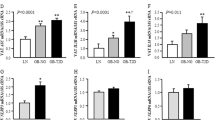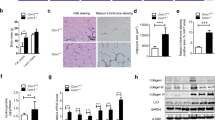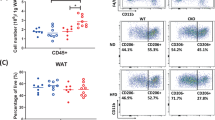Abstract
Objective:
Resolution of low-grade inflammation of white adipose tissue (WAT) is one of the keys for amelioration of obesity-associated metabolic dysfunctions. We focused on the identification of adipokines, which could be involved at the early stages of resolution of WAT inflammation.
Methods and procedure:
Male C57BL/6J mice with obesity induced in response to a 22-week feeding corn oil-based high-fat (cHF) diet were divided into four groups and were fed with, for 2 weeks, control cHF diet or cHF-based diets supplemented with: (i) concentrate of n−3 long-chain polyunsaturated fatty acids, mainly eicosapentaenoic and docosahexaenoic acids (cHF+F); (ii) thiazolidinedione drug rosiglitazone (cHF+TZD); and (iii) both compounds (cHF+F+TZD).
Results:
The short-term combined intervention exerted additive effect in the amelioration of WAT inflammation in obese mice, namely in the epididymal fat, even in the absence of any changes in either adipocyte volume or fat mass. The combined intervention elicited hypolipidaemic effect and induced adiponectin, whereas the responses to single interventions (cHF+F, cHF+TZD) were less pronounced. In addition, analysis in WAT lysates using protein arrays revealed that the levels of a small set of adipose tissue-related proteins, namely macrophage inflammatory protein 1γ, endoglin, vascular cell adhesion molecule 1 and interleukin 1 receptor antagonist, changed in response to the anti-inflammatory interventions and were strongly reduced in the cHF+F+TZD mice. These results were verified using both the analysis of gene expression and enzyme-linked immunosorbent analysis in WAT lysates. In contrast with adiponectin, which showed changing plasma levels in response to dietary interventions, the levels of the above proteins were affected only in WAT.
Conclusions:
We identified several adipose tissue-related proteins, which are locally involved in resolution of low-grade inflammation and remodelling of WAT.
This is a preview of subscription content, access via your institution
Access options
Subscribe to this journal
Receive 12 print issues and online access
$259.00 per year
only $21.58 per issue
Buy this article
- Purchase on Springer Link
- Instant access to full article PDF
Prices may be subject to local taxes which are calculated during checkout




Similar content being viewed by others
References
Dalmas E, Clement K, Guerre-Millo M . Defining macrophage phenotype and function in adipose tissue. Trends Immunol 2011; 32: 307–314.
Lumeng CN, Saltiel AR . Inflammatory links between obesity and metabolic disease. J Clin Invest 2011; 121: 2111–2117.
Sell H, Habich Ch, Eckel J . Adaptive immunity in obesity and insulin resistance. Nat Rev Endocrinol 2012; 8: 709–716.
Recchiuti A, Serhan CN . Pro-resolving lipid mediators (SPMs) and their actions in regulating miRNA in novel resolution circuits in inflammation. Front Immunol 2012; 3: 298.
Huber J, Loffler M, Bilban M, Reimers M, Kadl A, Todoric J et al. Prevention of high-fat diet-induced adipose tissue remodeling in obese diabetic mice by n-3 polyunsaturated fatty acids. Int J Obes (Lond) 2007; 31: 1004–1013.
Flachs P, Ruhl R, Hensler M, Janovská P, Zouhar P, Kus V et al. Synergistic induction of lipid catabolism and anti-inflammatory lipids in white fat of dietary obese mice in response to calorie restriction and n-3 fatty acids. Diabetologia 2011; 10: 2626–2638.
Itariu BK, Zeyda M, Hochbrugger EE, Neuhofer A, Prager G, Schindler K et al. Long-chain n-3 PUFAs reduce adipose tissue and systemic inflammation in severely obese nondiabetic patients: a randomized controlled trial. Am J Clin Nutr 2012; 96/5: 1137–1149.
Ruxton CH, Reed SC, Simpson MJ, Millington KJ . The health benefits of omega-3 polyunsaturated fatty acids: a review of the evidence. J Hum Nutr Diet 2007; 17/5: 449–459.
Flachs P, Rossmeisl M, Bryhn M, Kopecky J . Cellular and molecular effects of n-3 polyunsaturated fatty acids on adipose tissue biology and metabolism. Clin Sci 2009; 116: 1–16.
Flachs P, Horakova O, Brauner P, Rossmeisl M, Pecina P, Franssen-van Hal NL et al. Polyunsaturated fatty acids of marine origin upregulate mitochondrial biogenesis and induce beta-oxidation in white fat. Diabetologia 2005; 48: 2365–2375.
Kuda O, Jelenik T, Jilkova Z, Flachs P, Rossmeisl M, Hensler M et al. n-3 Fatty acids and rosiglitazone improve insulin sensitivity through additive stimulatory effects on muscle glycogen synthesis in mice fed a high-fat diet. Diabetologia 2009; 52: 941–951.
Sato A, Kawano H, Notsu T, Ohta M, Nakakuki M, Mizuguchi K et al. Antiobesity effect of eicosapentaenoic acid in high-fat/high-sucrose diet-induced obesity: importance of hepatic lipogenesis. Diabetes 2010; 59: 2495–2504.
Belzung F, Raclot T, Groscolas R . Fish oil n-3 fatty acids selectively limit the hypertrophy of abdominal fat depots in growing rats fed high-fat diets. Am J Physiol 1993; 264: R1111–R1118.
Raclot T, Groscolas R, Langin D, Ferre P . Site-specific regulation of gene expression by n-3 polyunsaturated fatty acids in rat white adipose tissues. J Lipid Res 1997; 38/10: 1963–1972.
Storlien LH, Kraegen EW, Chisholm DJ, Ford GL, Bruce DG, Pascoe WS . Fish oil prevents insulin resistance induced by high-fat feeding in rats. Science 1987; 237: 885–888.
Neschen S, Morino K, Dong J, Wang-Fischer Y, Cline GW, Romanelli AJ et al. N-3 fatty acids preserve insulin sensitivity in vivo in a PPAR{alpha}-dependent manner. Diabetes 2007; 56: 1034–1041.
Jucker BM, Cline GW, Barucci N, Shulman GI . Differential effects of safflower oil versus fish oil feeding on insulin-stimulated glycogen synthesis, glycolysis, and pyruvate dehydrogenase flux in skeletal muscle: a 13C nuclear magnetic resonance study. Diabetes 1999; 48: 134–140.
Kus V, Flachs P, Kuda O, Bardova K, Janovska P, Svobodova M et al. Unmasking differential effects of rosiglitazone and pioglitazone in the combination treatment with n-3 fatty acids in mice fed a high-fat diet. PLoS One 2011; 6: e27126–e27127.
Groeger AL, Cipollina C, Cole MP, Woodcock SR, Bonacci G, Rudolph TK et al. Cyclooxygenase-2 generates anti-inflammatory mediators from omega-3 fatty acids. Nat Chem Biol 2010; 6: 433–411.
Tsuchida A, Yamauchi T, Takekawa S, Hada Y, Ito Y, Maki T et al. Peroxisome proliferator-activated receptor (PPAR)alpha activation increases adiponectin receptors and reduces obesity-related inflammation in adipose tissue: comparison of activation of PPARalpha, PPARgamma, and their combination. Diabetes 2005; 54/12: 3358–3370.
Sugii S, Olson P, Sears DD, Saberi M, Atkins AR, Barish GD et al. PPARgamma activation in adipocytes is sufficient for systemic insulin sensitization. Proc Natl Acad Sci USA 2009; 106: 22504–22509.
Flachs P, Mohamed-Ali V, Horakova O, Rossmeisl M, Hosseinzadeh-Attar MJ, Hensler M et al. Polyunsaturated fatty acids of marine origin induce adiponectin in mice fed high-fat diet. Diabetologia 2006; 49/2: 394–397.
Neschen S, Morino K, Rossbacher JC, Pongratz RL, Cline GW, Sono S et al. Fish oil regulates adiponectin secretion by a peroxisome proliferator-activated receptor-gamma-dependent mechanism in mice. Diabetes 2006; 55: 924–928.
Kim H, Haluzik M, Gavrilova O, Yakar S, Portas J, Sun H et al. Thiazolidinediones improve insulin sensitivity in adipose tissue and reduce the hyperlipidaemia without affecting the hyperglycaemia in a transgenic model of type 2 diabetes. Diabetologia 2004; 47: 2215–2225.
Wang P, Renes J, Bouwman F, Bunschoten A, Mariman E, Keijer J . Absence of an adipogenic effect of rosiglitazone on mature 3T3-L1 adipocytes: increase of lipid catabolism and reduction of adipokine expression. Diabetologia 2007; 50: 654–665.
Tilg H, Moschen AR . Adipocytokines: mediators linking adipose tissue, inflammation and immunity. Nat Rev Immunol 2006; 6: 772–783.
Iwaki M, Matsuda M, Maeda N, Funahashi T, Matsuzawa Y, Makishima M et al. Induction of adiponectin, a fat-derived antidiabetic and antiatherogenic factor, by nuclear receptors. Diabetes 2003; 52: 1655–1663.
Maury E, Brichard SM . Adipokine dysregulation, adipose tissue inflammation and metabolic syndrome. Mol Cell Endocrinol 2010; 314: 1–16.
Hung J, McQuillan BM, Thompson PL, Beilby JP . Circulating adiponectin levels associate with inflammatory markers, insulin resistance and metabolic syndrome independent of obesity. Int J Obes (Lond) 2008; 32: 772–779.
Horakova O, Medrikova D, van Schothorst EM, Bunschoten A, Flachs P, Kus V et al. Preservation of metabolic flexibility in skeletal muscle by a combined use of n-3 PUFA and rosiglitazone in dietary obese mice. PLoS One 2012; 7: e43764.
Ruzickova J, Rossmeisl M, Prazak T, Flachs P, Sponarova J, Veck M et al. Omega-3 PUFA of marine origin limit diet-induced obesity in mice by reducing cellularity of adipose tissue. Lipids 2005; 12: 1177–1185.
Rossmeisl M, Macek JZ, Kuda O, Jelenik T, Medrikova D, Stankova B et al. Metabolic Effects of n-3 PUFA as phospholipids are superior to triglycerides in mice fed a high-fat diet: possible role of endocannabinoids. PLoS One 2012; 7: e38834.
Medrikova D, Macek JZ, Bardova K, Janovská P, Rossmeisl M, Kopecky J . Sex differences during the course of diet-induced obesity in mice: adipose tissue expandability and glycemic control. Int J Obes (Lond) 2011; 2: 262–272.
Dietze-Schroeder D, Sell H, Uhlig M, Koenen M, Eckel J . Autocrine action of adiponectin on human fat cells prevents the release of insulin resistance-inducing factors. Diabetes 2005; 54: 2003–2011.
Baumruk F, Flachs P, Horakova M, Floryk D, Kopecky J . Transgenic UCP1 in white adipocytes modulates mitochondrial membrane potential. FEBS Lett 1999; 444: 206–210.
Fujisaka S, Usui I, Bukhari A, Ikutani M, Oya T, Kanatani Y et al. Regulatory mechanisms for adipose tissue M1 and M2 macrophages in diet-induced obese mice. Diabetes 2009; 58: 2574–2582.
Wolf AM, Wolf D, Rumpold H, Enrich B, Tilg H . Adiponectin induces the anti-inflammatory cytokines IL-10 and IL-1RA in human leukocytes. Biochem Biophys Res Commun 2004; 323: 630–635.
Lawrence T, Gilroy DW, Colville-Nash PR, Willoughby DA . Possible new role for NF-kappaB in the resolution of inflammation. Nat Med 2001; 7: 1291–1297.
Kim CS, Kawada T, Yoo H, Kwon BS, Yu R . Macrophage inflammatory protein-related protein-2, a novel CC chemokine, can regulate preadipocyte migration and adipocyte differentiation. FEBS Lett 2003; 548: 125–130.
Nunez V, Alameda D, Rico D, Mota R, Gonzalo P, Cedenilla M et al. Retinoid X receptor alpha controls innate inflammatory responses through the up-regulation of chemokine expression. Proc Natl Acad Sci USA 2010; 107: 10626–10631.
Surmi BK, Webb CD, Ristau AC, Hasty AH . Absence of macrophage inflammatory protein-1{alpha} does not impact macrophage accumulation in adipose tissue of diet-induced obese mice. Am J Physiol Endocrinol Metab 2010; 299/3: E437–E445.
Hung SC, Chang CF, Ma HL, Chen TH, Low-Tone HL . Gene expression profiles of early adipogenesis in human mesenchymal stem cells. Gene 2004; 340: 141–150.
Shockley KR, Rosen CJ, Churchill GA, Lecka-Czernik B . PPARgamma2 regulates a molecular signature of marrow mesenchymal stem cells. PPAR Res 2007; 2007: 81219.
Xu F, Burk D, Gao Z, Yin J, Zhang X, Weng J et al. Angiogenic deficiency and adipose tissue dysfunction are associated with macrophage malfunction in SIRT1−/− mice. Endocrinology 2012; 153: 1706–1716.
Goldberg RB . Cytokine and cytokine-like inflammation markers, endothelial dysfunction, and imbalanced coagulation in development of diabetes and its complications. J Clin Endocrinol Metab 2009; 94: 3171–3182.
Bosanska L, Michalsky D, Lacinova Z, Dostalova I, Bartlova M, Haluzikova D et al. The influence of obesity and different fat depots on adipose tissue gene expression and protein levels of cell adhesion molecules. Physiol Res 2010; 59: 79–88.
Meier CA, Bobbioni E, Gabay C, Assimacopoulos-Jeannet F, Golay A, Dayer JM . IL-1 receptor antagonist serum levels are increased in human obesity: a possible link to the resistance to leptin? J Clin Endocrinol Metab 2002; 87/3: 1184–1188.
Cartier A, Bergeron J, Poirier P, Almeras N, Tremblay A, Lemieux I et al. Increased plasma interleukin-1 receptor antagonist levels in men with visceral obesity. Ann Med 2009; 41: 471–478.
Juge-Aubry CE, Somm E, Giusti V, Pernin A, Chicheportiche R, Verdumo C et al. Adipose tissue is a major source of interleukin-1 receptor antagonist: upregulation in obesity and inflammation. Diabetes 2003; 52: 1104–1110.
Acknowledgements
Our work was supported by the EU FP7 project DIABAT (HEALTH-F2-2011-278373), by the Ministry of Health of the Czech Republic (NT13763-4), RVO: 67985823, the Ministerium für Wissenschaft und Forschung des Landes Nordrhein-Westfalen, the Bundesministerium für Gesundheit, the Deutsche Forschungsgemeinschaft (SE 1922/2-1), the Commission of the European Communities (Collaborative Project ADAPT, contract number HEALTH-F2-2008-201100) and EU COST Action BM0602, and by EPAX AS (Aalesund, Norway).
Author information
Authors and Affiliations
Corresponding author
Ethics declarations
Competing interests
The authors declare no conflict of interest.
Additional information
Supplementary Information accompanies this paper on International Journal of Obesity website
Rights and permissions
About this article
Cite this article
Jilkova, Z., Hensler, M., Medrikova, D. et al. Adipose tissue-related proteins locally associated with resolution of inflammation in obese mice. Int J Obes 38, 216–223 (2014). https://doi.org/10.1038/ijo.2013.108
Received:
Revised:
Accepted:
Published:
Issue Date:
DOI: https://doi.org/10.1038/ijo.2013.108
Keywords
This article is cited by
-
Membrane and soluble endoglin role in cardiovascular and metabolic disorders related to metabolic syndrome
Cellular and Molecular Life Sciences (2021)
-
Mechanisms by Which Pleiotropic Amphiphilic n−3 PUFA Reduce Colon Cancer Risk
Current Colorectal Cancer Reports (2014)



